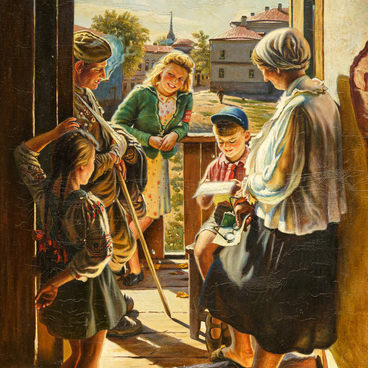Since ancient times, a tablecloth on the table has been considered a sign of wealth and prosperity. Tablecloths have been known in Russia since the early Middle Ages. Initially, the table was covered with a cloth only during meals. There was a period when it was used to decorate the interior. The turn of the 20th century is characterized by the active use of tablecloths as a decorative element of the interior of parlors and private rooms of the rich house owners. Long tablecloths reaching the floor were specifically selected to match the interior. They were often combined with the upholstery of furniture, the color of poufs and numerous cushions. White tablecloths with lace inserts were very popular, but velvet was also frequently used in rich homes.
The piece on display is a very interesting example of decorative and applied art. It is a square-shaped tablecloth made of thick velvety fabric of dark green (green willow) color. Natural, plant-based colors were popular during the Art Nouveau era. The color is complemented by embroidery: the tablecloth is decorated with a vegetal pattern around the edges, made by layering cord embroidery in beige, light brown and dark brown. The tablecloth was bought for the museum’s collection in 1999 to be part of the main exhibition.
The tablecloth looks especially striking, surrounded by furniture of the turn of the 20th century on an authentic table in combination with household items of the same era: an album, a box, and glasses. Velvet has been produced in Russia since the 17th century, until then it had been a purely imported commodity, brought in only from the East. This material is made on a special loom on which two layers of fabric are woven simultaneously. The finished layers are cut, so that pile is produced, and the two pieces of fabric are wound each on its own taker-in shaft. This is a very complex technological process making velvet production expensive before industrial looms became available, and high-quality velvet remained a rather costly fabric available to the wealthy.
The word “barkhat” (velvet in
Russian) goes back to the Arabic-Turkic “barracan” — “a kind of black
clothing”; it was borrowed into the Russian language through German and Polish.

